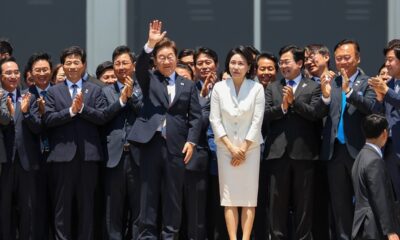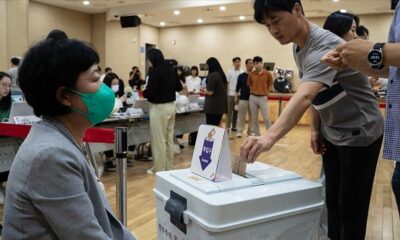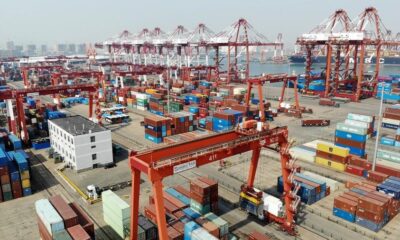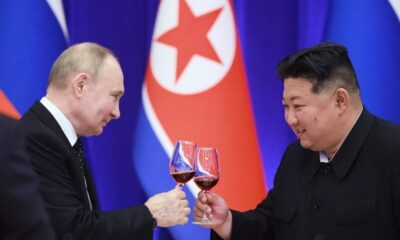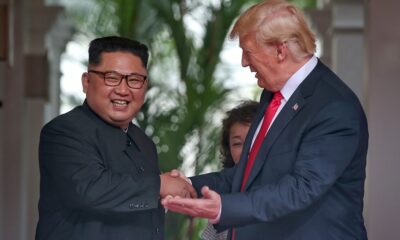Asia
Technical and political messages of the “Hwasong-15” test
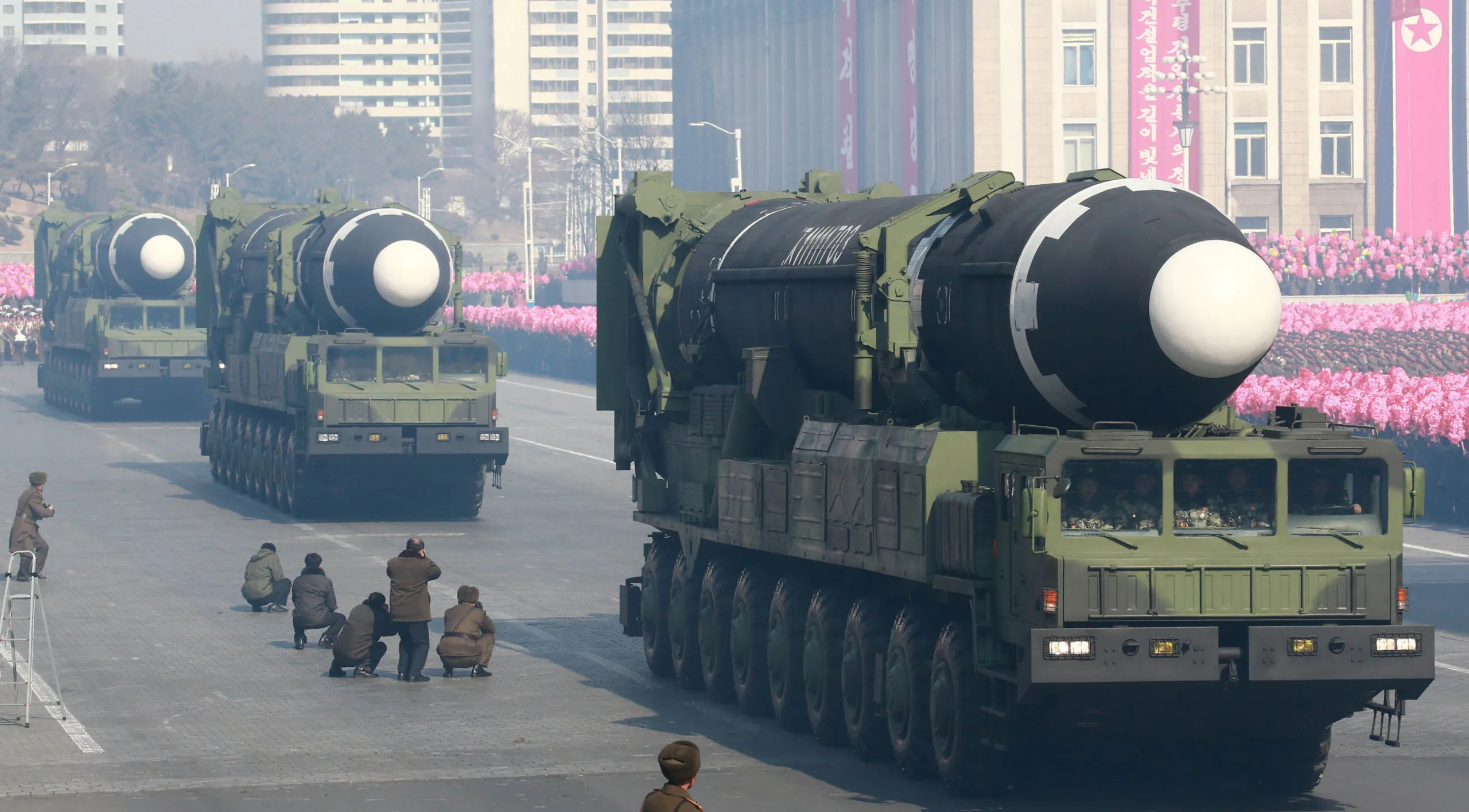
The Democratic People’s Republic of Korea (DPRK) conducted a Hwasong-15 intercontinental ballistic missile (ICBM) test on Saturday as a warning to the United States and South Korea and to test the readiness of special units under its newly formed Missile General Bureau.
“The military threats of the United States and South Korea are becoming too serious to be ignored,” the Korean Central News Agency (KCNA) reported on Sunday, noting that it has demonstrated its “efforts to turn its capacity of fatal nuclear counterattack on hostile forces.”
Kim Yo Jong, sister of the country’s leader Kim Jong Un, had warned Seoul and Washington of a “overwhelming counteraction” to “hostility” in a separate statement published by KCNA on Sunday. South Korean fighter jets flew alongside American F-16 fighter jets to escort South Korean warplanes and a B-1B bomber, the South Korean Joint Chiefs of Staff said on Sunday.
“The training aimed at demonstrating the timely and immediate deployment of the U.S. extended deterrence assets to the Korean Peninsula,” the statement said.
Following a joint flight report from South Korea, two short-range ballistic missiles fired from Sukchon areas in South Pyongan province of the DPRK into the East Sea at 06:59 and 07:04 am on February 20, 2023. It is reported that the artillery unit of the Korean People’s Army fired two shots from the 600-mm multiple rocket launcher during firing drills, and that they flew 395 km and 337 km, respectively.
Extended deterrence: Hwasong-15 (KN-22)
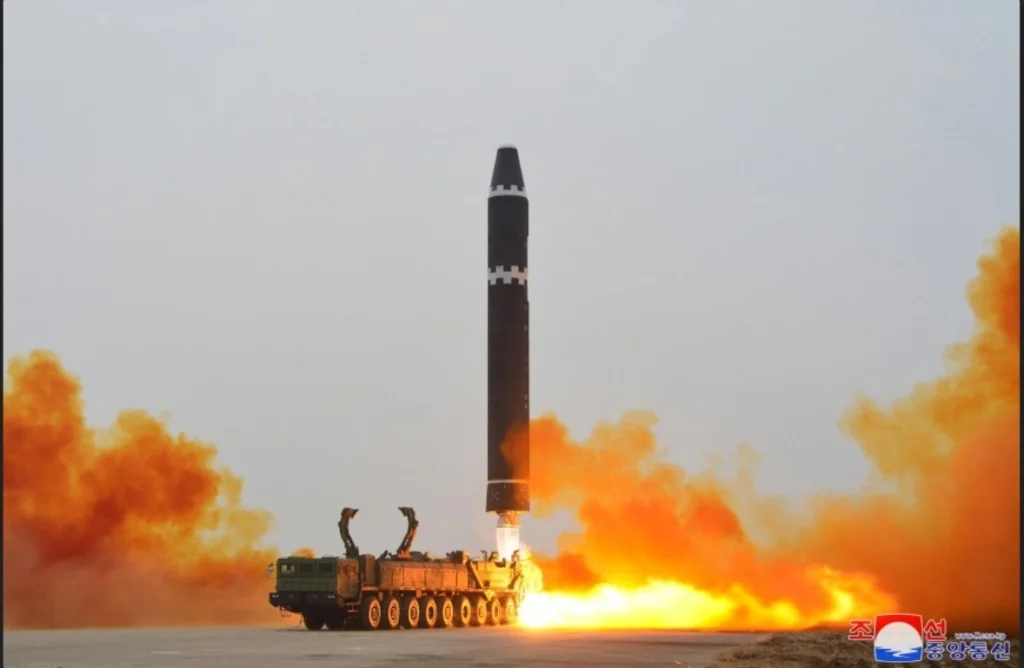
The missile, which was launched from Pyongyang International Airport on Saturday at 17.22 KST and hit a target in international waters 989 km away within the borders of the Sea of Japan, reportedly achieved maximum performance. The missile set a new record with a total of 66 minutes of flight at an altitude of about 5,768 km.
The DPRK began developing the Hwasong-15 sometime before 2017. The U.S. intelligence community had pointed out that it was aware of the development of the Hwasong-15 before its first test, and that the design was entirely in partnership with the Hwasong-14 and Hwasong-12 missile designs.
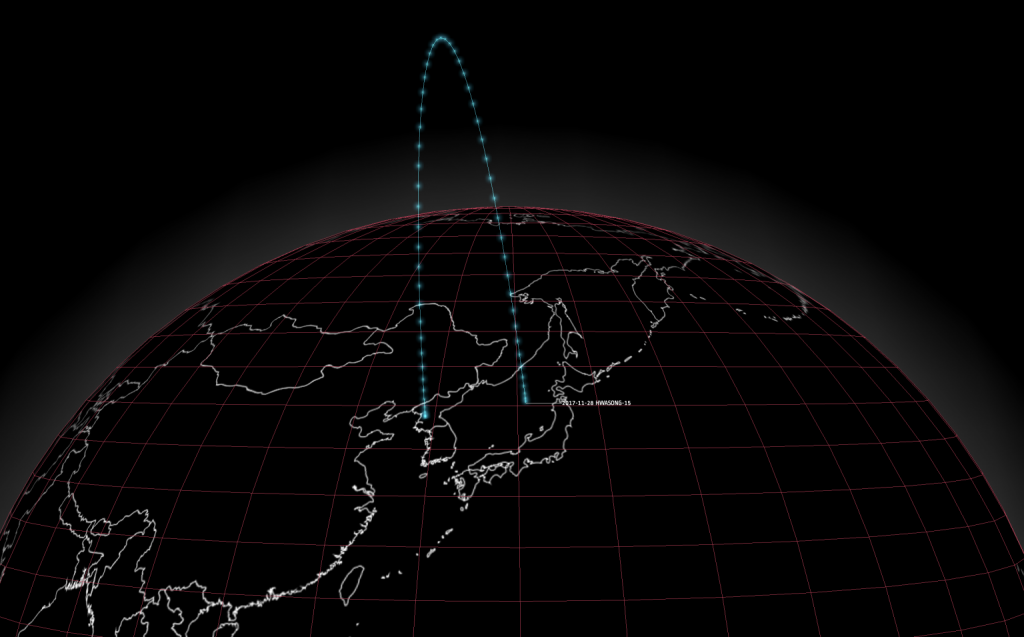
The HWASONG-15, which was first tested for the first time on November 28, 2017, was flying for 53 minutes to reach a maximum height of 4,500 km and 960 km.
The Hwasong-15 was first tested on November 28, 2017, from a site 30 km north of Pyongyang, revealing changes in the engine and launch values. In its first test, the missile flew for 53 minutes, reaching a maximum altitude of 4,500 km and a range of 960 km. Thus, it was reported that the missile could travel up to 10,000 km, enough to hold the continental United States at risk.
Technical development process and increased range
Although the missile appears to employ two of the Hwasong-14’s “Korean-style high-thrust” engines in its first stage, it is powered by Pektusan-B variant engines, an indigenously produced variant of the Soviet-designed RD-250 engine, each of which exerts 48 tons of thrust.
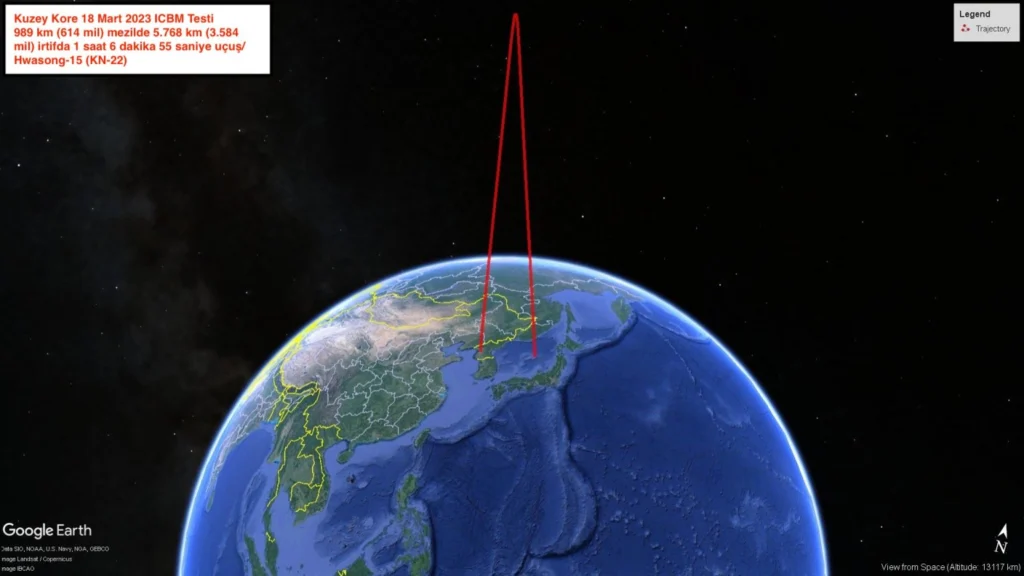
This increases the take-off thrust compared to the HS-14 only to 170% (788 kN SL) because the steering engines are missing. The function of the steering engines is provided through vectors on the main engine. The propulsion of the second stage, which will take place after 129 seconds, is completely unclear. The second stage is probably to be powered by a down-scaled Unha-3 variant engine. Considering these values, it points to a longer range than the first test, with engines and missile technology being developed day by day. Statements, flight values and technical information from Pyongyang include a range of 13,000 km.

Source: N.Brügge
On Saturday, Japanese Defense Minister Yasukazu Hamada said that “the missile was estimated to have a range of over 14,000 km, in this case, that would put the entire United States within its range,” confirming the progress of the DPRK missile development process.
Kim Yo-jong vows unprecedented strong responses
Speaking after the launch, U.S. Secretary of State Antony Blinken said that “the United States are prepared to engage with North Korea without any preconditions.”
Kim Yo-jong, sister of DPRK leader Kim Jong-un and chairman of the State Affairs Commission, made harsh statements.
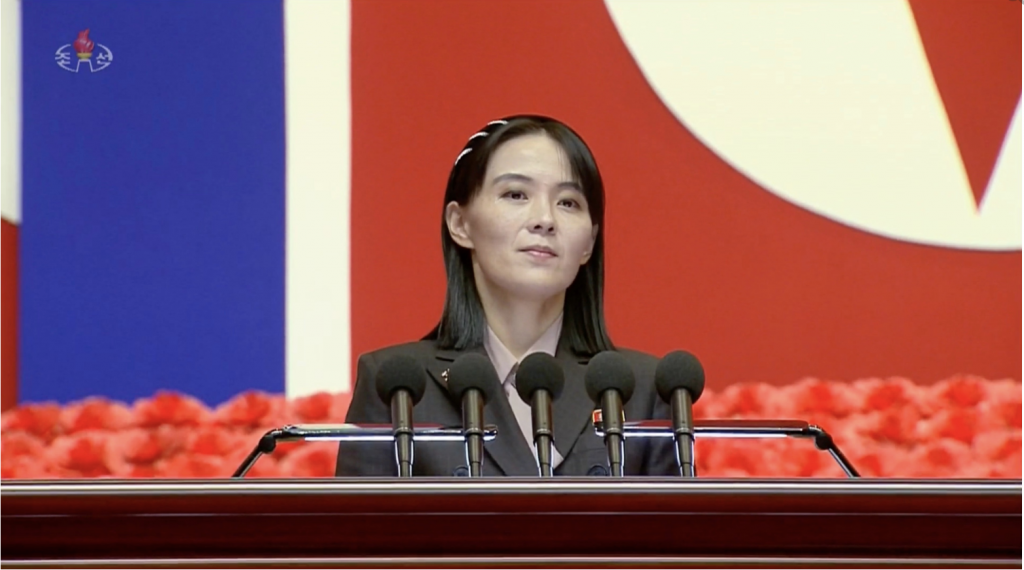
Kim Yo-jong – (DPRK) Deputy Department Director of the Publicity and Information Department of the Workers’ Party of Korea
Kim said they never trusted Washington’s repeated assurances that it did not have a hostile policy towards Pyongyang, adding: “I warn that we will watch every movement of the enemy and take corresponding and very powerful and overwhelming counteractions against every move hostile to us.”
Addressing their stance on South Korea, Kim reassured that “intercontinental missiles will not be aimed at Seoul,” adding that the DPRK leadership “still has no intention of engaging in dialogue.”
South Korean government wants to gain momentum on ‘nuclear weapons’
The South Korean ruling People Power Party (PPP) warned that if Pyongyang “continues its military provocations, South Korea will accelerate its acquisition of its own nuclear weapons.”
Party spokesman Chung Jin-suk said: “We have a clear option on North Korea’s nuclear weapons. We must first secure a concrete nuclear deterrence.”
Asia
Iran-Israel war: Why US discusses regional conflict with Pakistan
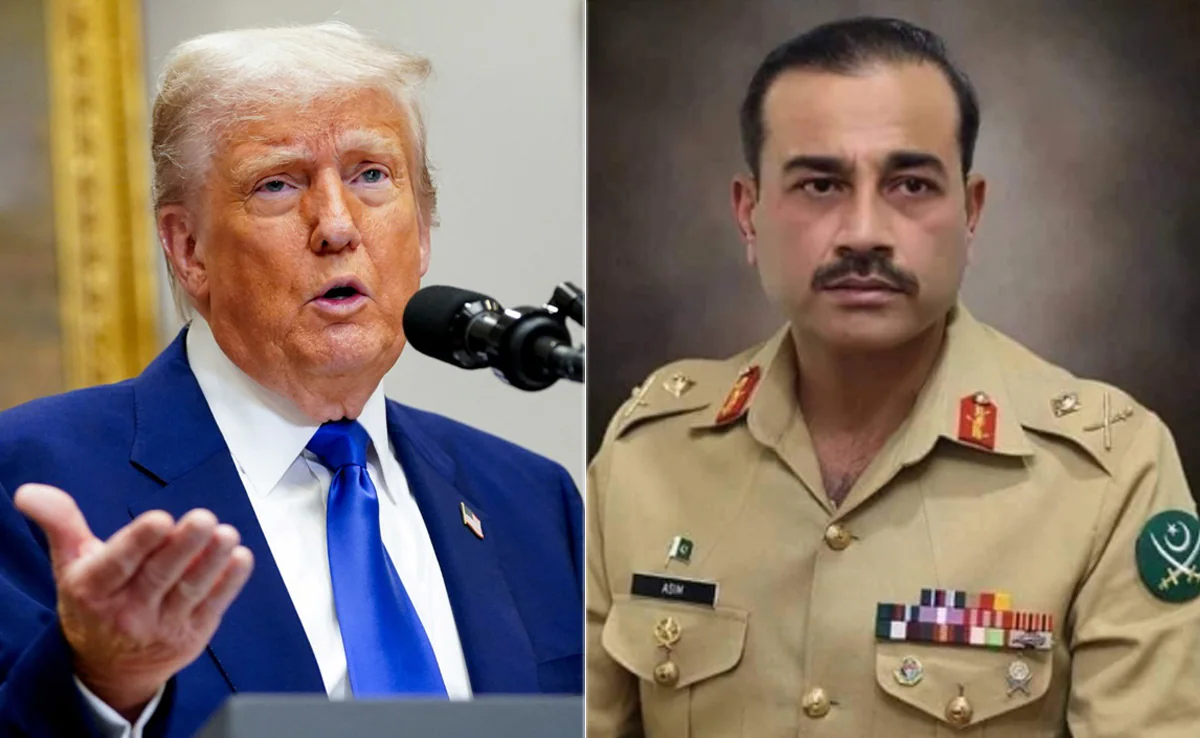
US President Donald Trump and Pakistan’s Army Chief General Asim Munir held a special and important meeting during a time when tensions are rising in the Asian region. The meeting was held on Trump’s invitation and was not open to the media. However, both sides have released official statements afterward, which states that the main topics were discussed
The meeting focused on the ongoing conflict between Iran and Israel, Pakistan–India relations, especially the Kashmir issue, the situation in Afghanistan and future US–Pakistan cooperation.
Pakistan has recently improved its strategic position in the region. It has shown strong ties with China and is the only South Asian country openly supporting Iran in its conflict with Israel. Meanwhile, Pakistan remains an important player in Afghanistan.
Why the Pakistani Army Chief was invited to the US?
Although Pakistan has an elected civilian government, important decisions—especially related to foreign affairs and security—are often handled by the military. That’s why General Asim Munir was invited to meet Trump instead of the Prime Minister, General Munir’s influence has grown recently. After tensions with India, he was given the title of Field Marshal. His meeting with Trump is seen as a sign of his importance in both Pakistani and international politics.
According to the Pakistan Army’s media wing (ISPR): General Munir thanked President Trump for helping to ease recent tensions between Pakistan and India. Trump praised Pakistan’s role in fighting terrorism. Both agreed to work together in the future, especially in: Trade, Technology Minerals and energy Artificial intelligence Crypto currency and regional peace efforts as well.
President Trump also appreciated General Munir’s leadership during difficult times. Munir invited Trump to visit Pakistan, and Trump reportedly accepted the offer in principle.
Why US former peace envoy to Afghanistan, Khalilzad is not trusting Pakistan’s army chief
Former U.S. diplomat Zalmay Khalilzad criticized the meeting. He said General Munir cannot be trusted and reminded the U.S. that Pakistan has supported groups that harmed American soldiers in the past. According to Khalilzad, General Munir may be trying to get U.S. support for his interests in Afghanistan, which he believes could be risky for America.
Though no official list of US demands was made public, reports suggest a meeting was held in Saudi Arabia earlier, where American officials spoke with top Pakistani leaders. During that meeting, the U.S. reportedly made four key requests: Pakistan should help the U.S. in counterterrorism operations when needed. Pakistan should slowly reduce its relations with China. Pakistan should recognize Israel after Saudi Arabia does. If the U.S. attacks Iran, Pakistan should support the U.S. instead of staying neutral.
These demands are similar to earlier U.S.–Pakistan arrangements during the Cold War and the War on Terror.
What could be expected in the future?
This meeting could mark the beginning of a new phase in US–Pakistan relations. In the past, Pakistan helped the U.S. during the Soviet-Afghan War and after 9/11. Now, with tensions involving Iran, India, and Afghanistan—and China expanding its role—the U.S. may again be looking to Pakistan as a key partner in the region.
Time will tell whether this leads to a long-term partnership or just another temporary agreement based on short-term goals.
Asia
China pledges aid and signs friendship treaty at Central Asia summit
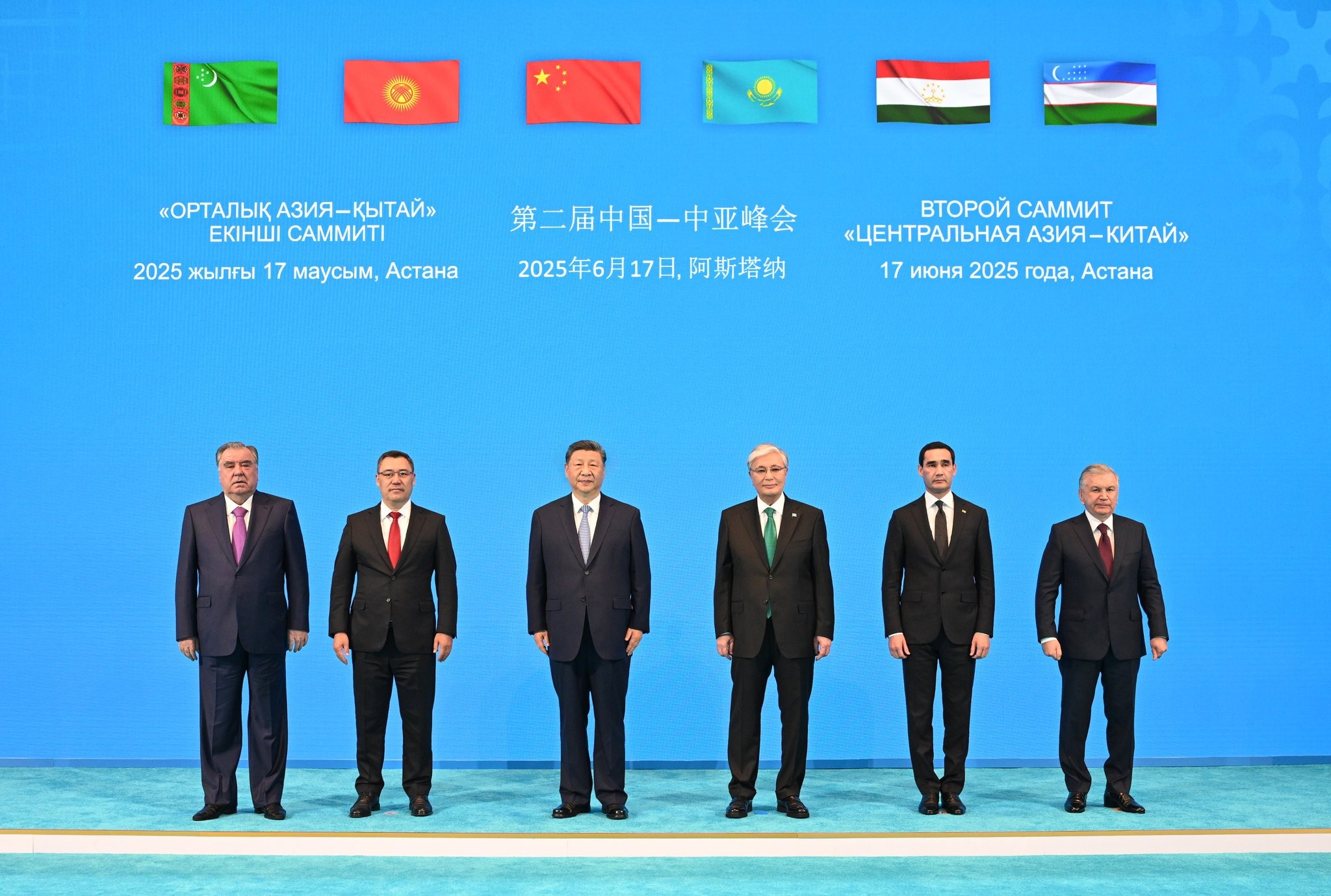
China concluded its latest engagement efforts in Central Asia on Tuesday by pledging 1.5 billion yuan (US$209 million) for livelihood and development projects in the region.
The six nations participating in the second China-Central Asia Summit also signed a historic permanent friendship treaty.
“China is ready to provide 1.5 billion yuan in grant assistance to Central Asian countries this year to support livelihood and development projects of common interest to each country,” Chinese President Xi Jinping stated in his opening address at the summit in Astana, the capital of Kazakhstan.
“Additionally, China will offer 3,000 training opportunities to Central Asian countries over the next two years.”
Xi described the signing of the Permanent Good-Neighborliness and Friendly Cooperation Agreement as a milestone in relations between the six countries, calling it “an innovative initiative in China’s neighborhood diplomacy and a contribution that will benefit future generations.”
China has signed similar agreements with Russia and Pakistan.
Xi also emphasized the need for cooperation in a world that has entered “a new period of turbulence and transformation.”
State news agency Xinhua quoted Xi as saying, “There will be no winner in a tariff and trade war. Protectionists and hegemonists will harm both others and themselves.”
“The world should not be divided, but united; humanity should not revert to the law of the jungle, but work to build a common future for mankind,” he added.
Xi also announced the establishment of three cooperation centers focusing on poverty reduction, educational exchange, and desertification control, as well as a trade facilitation platform under the China-Central Asia cooperation framework.
In a statement on Wednesday, the Chinese Foreign Ministry said that China and the Central Asian countries are eager to improve road and rail connectivity and plan to open more direct flights to and from China to increase mutual exchange.
China will consider simplifying visa procedures with the five Central Asian countries, while all parties will study the feasibility of opening consulates.
Together with Kazakhstan, Kyrgyzstan, and Tajikistan, China will accelerate the modernization of existing port facilities and assess the need for new ones.
The summit was the second of its kind, following the inaugural one held two years ago in Xian, China.
These efforts reflect a deepening of China’s relations with Central Asia, which have historically focused on areas such as transportation infrastructure.
The region is a key part of the Belt and Road Initiative, Beijing’s global development strategy, and China has invested heavily in energy pipelines, infrastructure, and mining projects in Central Asia.
However, China also wants to expand cooperation into sustainable development and renewable energy.
These investments were a major focus of Xi’s meetings with the leaders of the five Central Asian states.
During the meetings, Xi stressed the need to uphold multilateralism and the global trade order. This is part of Beijing’s effort to position itself as a more reliable partner following the US tariff war.
Meeting with Turkmen President Serdar Berdimuhamedov, Xi called for expanding gas cooperation and exploring opportunities in non-resource sectors.
Security was also on the agenda.
“The two countries should further strengthen law enforcement, security, and defense cooperation, jointly combat the ‘three forces,’ and enhance cooperation in cybersecurity,” Xi said, referring to “terrorism, separatism, and extremism.”
Beijing views these forces as threats to national and regional security, and Xi has repeatedly emphasized this stance in his meetings with Central Asian leaders.
While China’s presence in Central Asia has historically focused on economic investments, its influence in the security sphere is growing through joint counter-terrorism drills, training programs, and aid.
This is particularly true in Tajikistan, which shares a long border with Afghanistan, where China is concerned about terrorists returning to carry out operations in its western Xinjiang region.
In his meeting with Tajik President Emomali Rahmon, Xi called for deeper cooperation in law enforcement and security to combat the three forces.
He also called for increasing bilateral trade and investment and improving transportation infrastructure.
Rahmon said Dushanbe would expand cooperation in new areas such as new energy, green industries, and artificial intelligence, and would “strengthen coordination with Beijing for the Shanghai Cooperation Organisation (SCO) to play a greater role.”
The SCO is the main forum for relations between China and the landlocked region. This political, economic, and security bloc was founded in 2001 by China, Kazakhstan, Kyrgyzstan, Russia, Tajikistan, and Uzbekistan. Turkmenistan, reflecting its commitment to “permanent neutrality,” is the only Central Asian country outside the organization.
On Tuesday, Xi also held talks with Kyrgyz President Sadyr Japarov, describing relations between the two countries as being in “the best period in history.”
Xi said the construction of the China-Kyrgyzstan-Uzbekistan railway is a top priority, but new growth drivers such as clean energy, green mining, and artificial intelligence should also be developed.
The talks followed the signing of cooperation documents between China and the summit’s host country, Kazakhstan, covering trade, investment, technology, tourism, and customs.
Xi asked his Kazakh counterpart, Kassym-Jomart Tokayev, to accelerate cross-border railway projects and the improvement of port infrastructure.
Xi also stated, “Beijing and Astana should be strong supporters of each other in turbulent times.”
According to the Kazakh presidential office, Tokayev described relations between the two countries as stable and “not negatively affected by geopolitical challenges and turmoil or the international situation.”
Asia
Iran’s uranium enrichment program since 1979
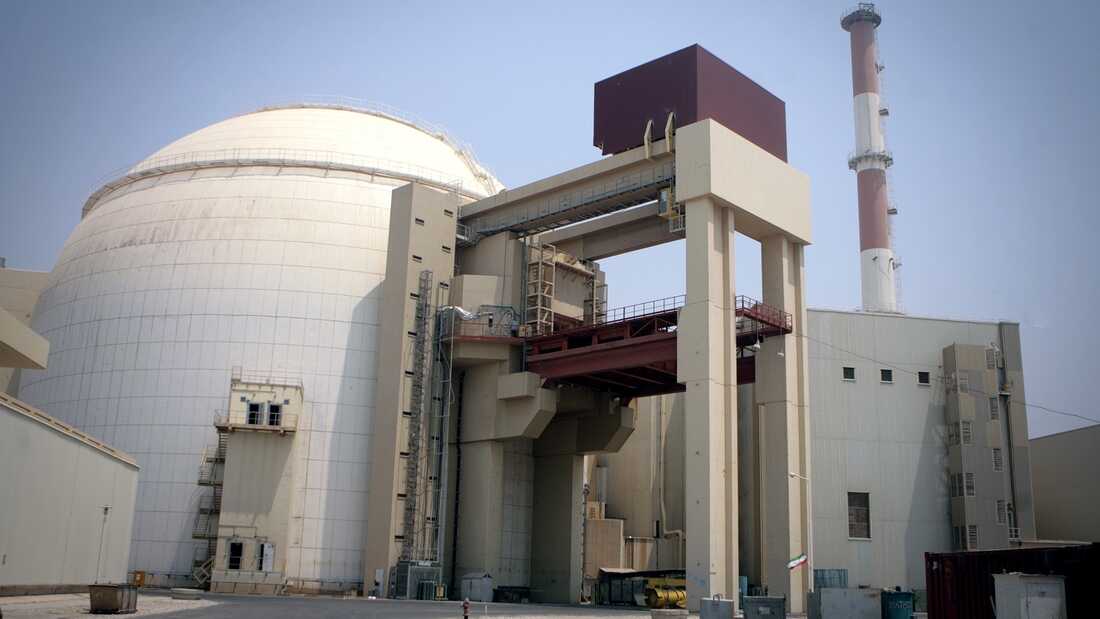
Iran’s uranium enrichment program underwent major changes after the Islamic Revolution in 1979. During the Pahlavi dynasty, Iran had extensive cooperation with Western countries and even received offers to participate in enrichment consortiums.
But after the revolution, this cooperation stopped and Iran pursued the independent development of its own nuclear technology. In the 1980s, Iran was able to achieve an enrichment level of 3.67 percent, which was suitable for supplying fuel to nuclear power plants.
Over time, this rate increased, reaching 60 percent at some points, which raised concerns internationally. Accordingly, the JCPOA, a nuclear agreement between Iran and world powers, was signed in 2015. The agreement was concluded by Iran and the P5+1 group (the United States, UK, France, Russia, China, and Germany) and aimed to limit Iran’s nuclear program in exchange for the lifting of economic sanctions.
Under the deal, Iran committed to limiting its enrichment level to 3.67 percent and reducing its stockpile of enriched uranium. Extensive monitoring by the International Atomic Energy Agency was also imposed on Iran’s nuclear facilities.
US withdrawal from the JCPOA caused Iran to gradually reduce its commitments and increase its enrichment level.
But in 2018, the US administration under Donald Trump withdrew from the JCPOA agreement. The reasons for this withdrawal included US concerns about Iran’s regional influence and the lack of coverage of Iran’s missile program in the agreement.
The US withdrawal from the JCPOA caused Iran to gradually reduce its commitments and increase its enrichment level. In the following years, Iran announced that it had achieved 60pc enrichment and even had plans to increase this level further.
Because uranium enrichment has many applications – at low levels (3.67 percent), it is used to produce fuel for nuclear power plants. At higher levels (20 percent), it has medical applications, including the production of radioactive isotopes for cancer treatment.
But enrichment at 90 percent would lead to the production of nuclear weapons, although Iran has always insisted that its nuclear program is peaceful.
Deadly conflict between Iran and Israel, the two arch-enemy and its impact on the region
The conflict between Iran and Israel is also directly related to Iran’s nuclear program. Israel has always considered Iran’s nuclear program a threat to its security and has in some cases launched cyberattacks and even physical attacks on Iranian nuclear facilities.
On the other hand, Iran considers Israel a threat to the region and supports resistance groups in the region. These tensions have made the Iranian nuclear issue one of the main axes of regional disputes.
Meanwhile, the war between Iran and Israel has widespread effects on the region and especially on the economies of neighboring countries, including Afghanistan.
This conflict not only has military and political consequences, but has also affected the economy of the region and increased economic instability.
Israeli attacks on Iran’s nuclear and military facilities, especially oil facilities, could reduce Iran’s oil production and exports.
This will lead to an increase in global oil prices, which will have a direct impact on the economies of countries that depend on energy imports. Countries in the region, including Turkey, Iraq, and Afghanistan, which source some of their energy from Iran, will face increased import costs.
However, Afghanistan will be directly affected by the war due to its heavy dependence on imports from Iran. The country imports many consumer goods, including food, fuel, and construction materials, from Iran.
The energy crisis is also a major consequence of the conflict between Iran and Israel
If the war intensifies, these imports will be disrupted and prices will increase. The energy crisis is also a major consequence of the conflict. Afghanistan gets a significant portion of its electricity from Iran, and if Iran’s energy exports decrease, Afghanistan will face a power shortage, which will have a negative impact on industries and the daily lives of people. Disruption of trade routes is another consequence of this war.
Reduced imports from Iran and increased transportation costs will increase inflation in Afghanistan, which will put more economic pressure on the people.
These effects occur through several economic and geopolitical mechanisms. New sanctions against Iran could reduce the country’s exports and increase the price of imported goods to Afghanistan.
Regional instability could also increase insecurity on the Iranian-Afghan border, which would affect trade and investment.
Military conflicts could make trade routes unsafe and increase the cost of transporting goods. A prolonged Iran-Israel war would be not only a military crisis, but also an economic crisis for the region and Afghanistan.
Rising oil prices, disruptions in trade, an energy crisis, and inflation are among the consequences of this war. Afghanistan, due to its heavy dependence on imports from Iran, will be the most affected and may face serious economic and social problems. The future of this crisis depends on diplomatic decisions and regional developments; but what is certain is that its economic effects will be widespread and long-lasting.
-
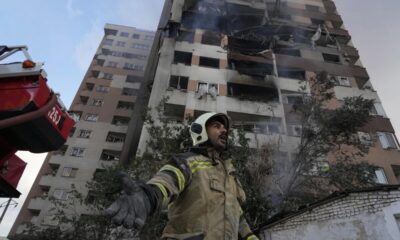
 Diplomacy6 days ago
Diplomacy6 days agoFormer diplomat warns forcing Iran out of the NPT is the greatest danger
-
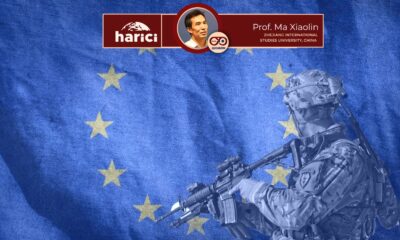
 Opinion2 weeks ago
Opinion2 weeks agoEuropean defense autonomy and Germany’s military role enter a turning point
-
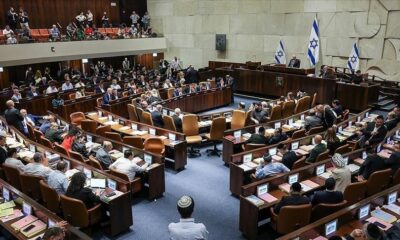
 Middle East1 week ago
Middle East1 week agoNetanyahu’s government survives no-confidence vote as Haredi crisis is delayed
-
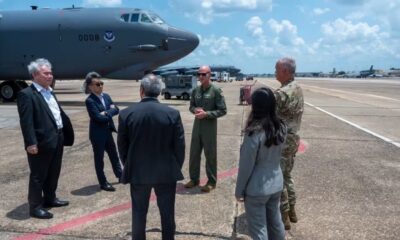
 Asia1 week ago
Asia1 week agoJapan, US showcase B-52 bombers in nuclear deterrence dialogue
-
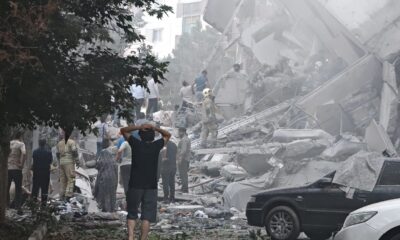
 Diplomacy6 days ago
Diplomacy6 days agoFormer CIA analyst says Israel used ceasefire talks as a trap
-
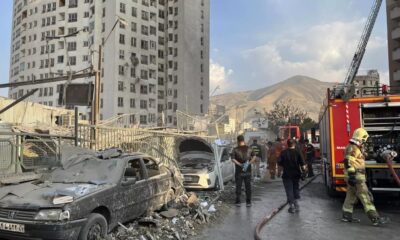
 Middle East1 week ago
Middle East1 week agoIsrael strikes Iran’s nuclear program, killing high-level commanders
-
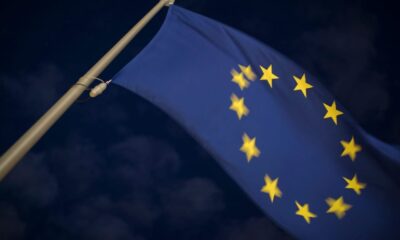
 Europe1 week ago
Europe1 week agoBrussels prepares to sanction two Chinese banks over Russia ties
-
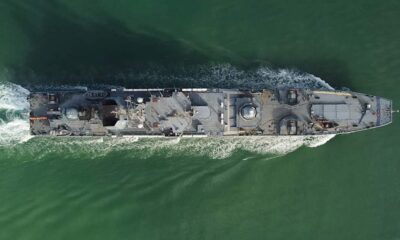
 Russia1 week ago
Russia1 week agoRussia outlines naval development plan through 2050


